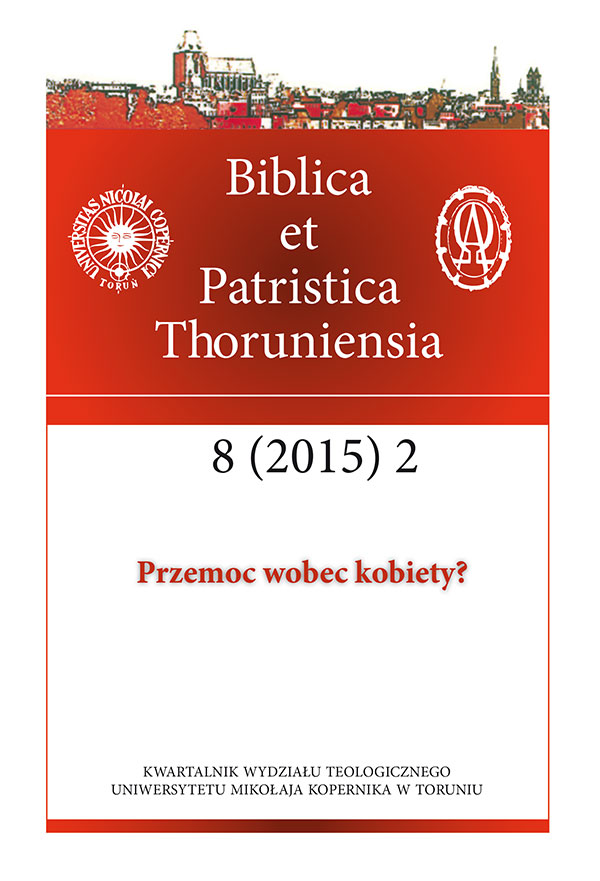Is the patriarchal system could foster violence against women?
DOI:
https://doi.org/10.12775/BPTh.2015.008Keywords
the creation of man, patriarchy, saint Paul, the liturgical assembly, woman and man, wife and husband, violence against womenAbstract
The belief that patriarchy could foster violence against women is pretty widely adopted paradigm, especially in regard to societies that feel relationship with the teachings of the Bible. So we have to ask ourselves first and foremost question: Is the biblical texts where we can find grounds for such a judgment? And then: Do we properly understand these texts that seem to suggest the dominance of man over woman? And again: How much of our behavior is influenced by the teaching of the Bible, and to what extent this is the result of social conditions that shaped independently from the original source, or even in opposition to it? As the basis for answers to these questions we took three biblical texts, one from the Old Testament (Gen 1:26–27; 2:7.21–23) and two from the new one (1 Co 14:33b–35 and 1Tim 2:11–15) . The research shows that in Genesis we see a revolutionary change, bordering almost with a kind of social revolution. Here it turns out that both in the text dating from the X c. BC. (Gen 2:7.21–23) and in that of approx. V in. BC. (Gen 1:26–27) a woman is not inferior to a man in anything. They are completely equal. Observing the situation in Corinth, to which Paul responds in a very decisive manner (1 Co 11:2–16; 14:33b–36), it seems that once again everything goes back to “normal” for the domination of man. However, it is not. Firstly, in response to a specific situation, that is demanding from women fulfilling their cultic functions. Secondly, the comments concerning the behavior of women and men in the liturgy contain a model of an ideal disciple (female) and an ideal teacher (male). As we know, the student listens as long as is a disciple. When he ceases to be a disciple, he ceases to remain silent and becoming a teacher starts talking. The same applies to the indications included in 1 Tim 2:11–15. The woman, as a mother and wife had a clearly defined and privileged position in marriage and family. But she could not move this position to liturgical assembly, even if they took place in the house, which was owned by her husband. So the final conclusion is that patriarchy, although firmly rooted in Judaism and from there taken by Christianity, does not have to foster depreciating of the position of women in society. The analyzed texts tend to support the position equal to man, although both a woman, and a man have their proper position in the liturgical assembly, according to the received charisms.
References
Brzegowy T., Pięcioksiąg Mojżesza, Tarnów 1995.
Cipriani S., Lettere Pastorali, 1–2 Timoteo. Tito. Versione, troduzione, note, Roma 1972
Czerski J., Pierwszy List do Koryntian, Wrocław 2009.
Fabris R., Prima Lettera ai Corinzi. Nuova versione, introduzione e commento, Milano 2005.
Haag H., Schöpfungsbericht, w: Bibel Lexikon (red. H. Haag), Zürich–Köln 1968, 1554.
Hergesel T., Rozumieć Biblię, t. I: Stary Testament. Jahwizm, Kraków1990.
Jankowski A., Romaniuk K., Stachowiak L., Komentarz praktyczny do Nowego Testamentu, Poznań–Warszawa 1975.
Marcheselli-Casale C., Le Lettere Pastorali. Le due lettere a Timoteo a la lettera a Tito. Introduzione, versione, commento, Bologna 1995.
Rosik M., Pierwszy List do Koryntian. Wstęp, przekład z oryginału, komentarz, Częstochowa 2008.
Stasiak S., Komentarz do Dziejów Apostolskich, Listu do Rzymian, 1–2 Listu do Koryntian i Listu do Galatów (Komentarz teologiczno-pastoralny do Biblii Tysiąclecia. Nowy Testament 2), Poznań 2014.
Zimmerli W., 1. Mose 1–11. Die Urgeschichte, Zürich 31967.
Downloads
Published
How to Cite
Issue
Section
License
CC BY ND 4.0. The Creator/Contributor is the Licensor, who grants the Licensee a non-exclusive license to use the Work on the fields indicated in the License Agreement.
- The Licensor grants the Licensee a non-exclusive license to use the Work/related rights item specified in § 1 within the following fields: a) recording of Work/related rights item; b) reproduction (multiplication) of Work/related rights item in print and digital technology (e-book, audiobook); c) placing the copies of the multiplied Work/related rights item on the market; d) entering the Work/related rights item to computer memory; e) distribution of the work in electronic version in the open access form on the basis of Creative Commons license (CC BY-ND 3.0) via the digital platform of the Nicolaus Copernicus University Press and file repository of the Nicolaus Copernicus University.
- Usage of the recorded Work by the Licensee within the above fields is not restricted by time, numbers or territory.
- The Licensor grants the license for the Work/related rights item to the Licensee free of charge and for an unspecified period of time.
FULL TEXT License Agreement
Stats
Number of views and downloads: 943
Number of citations: 0



